Compared: Apple's iPhone 11 Pro Max versus the Samsung Galaxy Note 10 and 10+
The iPhone 11 Pro Max may be the most high-specification model available from Apple, but how does it shape up against its main rival, the Samsung Galaxy Note 10 and the Note 10+? AppleInsider compares the specifications to determine an on-paper winner.
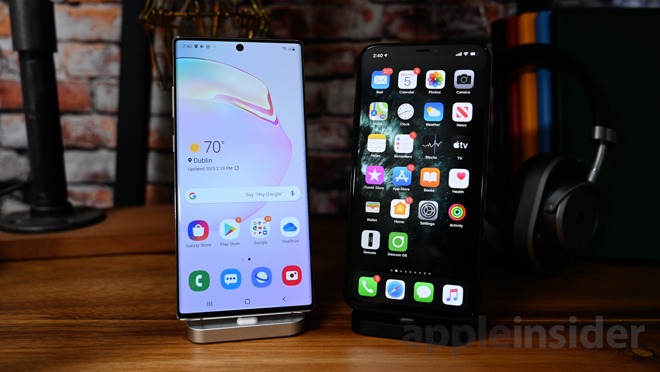
Samsung Galaxy Note 10+ against the iPhone 11 Pro Max
Revealed just a month ahead of Apple's annual iPhone event, Samsung's Galaxy Note 10 and Note 10+ were revealed as potential smartphone powerhouses, with a large display and a rear triple-camera setup that is relatively similar to what was presented by Apple in the iPhone 11 Pro and Pro Max a few weeks later.
With the launches so close together and being the flagship models of their respective manufacturers, it is worth taking some time to compare the offerings against each other, to see who has the upper hand for the next year or so.
While the basic list of specifications can certainly give the appearance of similarities in some areas and larger differences in others, like with the Note's rear cameras against Apple's being fairly close in many respects, there's more variation in the two different families of devices than numbers alone can advise about.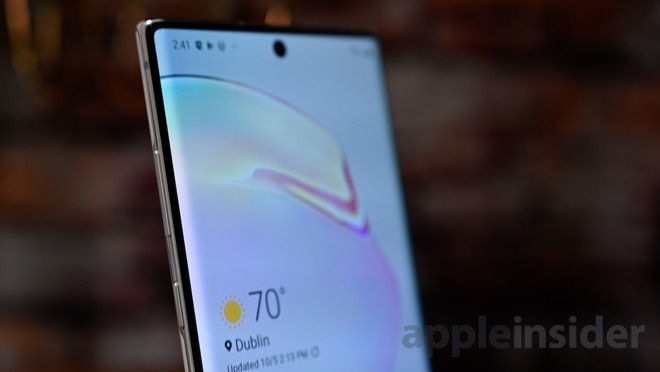
Samsung Galaxy Note 10+ display
All models employ an OLED panel for their screens, which means both offer high levels of contrast and brightness. Indeed, since Samsung supplies Apple with OLED panels for its iPhones, the technology and quality should be quite comparable from a manufacturing standpoint.
The iPhone 11 Pro Max slots in the space between the Note 10 and Note 10+, at 6.5 inches to the Samsung 6.3 inches and 6.8 inches. The resolution is also roughly in the middle of the two Samsung models as well, with its pixel density of 458 pixels per inch sandwiched between the 401ppi for the Note 10 and the 498ppi of the Note 10+.
While you are likely to find the quality of the display on all three models to be quite agreeable, one big difference is how the two companies handled the extra components on the front of the device. Apple continues to endure with the infamous notch holding the TrueDepth camera array, while Samsung elects for a hole-punch camera design that minimizes wasted space.
It is hard to judge one over the other, as while you have more screen with the Samsung models, both do ultimately interrupt a full-screen appearance with an aberration, one that cannot easily be dismissed from view. Samsung's may be smaller, but it's still a distraction.
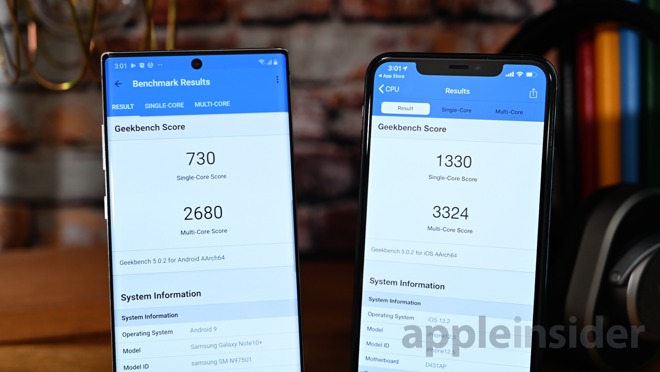
Geekbench 5 results for the iPhone 11 Pro Max (right) and the Galaxy Note 10+ (left)
In benchmark results at least, the A13 seems to have done the job. According to GeekBench, the A13 Bionic in the iPhone 11 Pro Max scores 1,329 points on single-core processing to the Note 10's 697 points, while for multi-core, Apple wins again with 3,405 to Samsung's 2,523.
The story doesn't get any better for Samsung in GeekBench's Compute benchmark, with Apple achieving 6,288 points for Metal over 2,307 for the Note 10's OpenCL score. While this isn't a direct comparison due to differing technologies, it does indicate the iPhone continues to be far in the lead in this respect.
Why is the A13 doing so well, despite having half the RAM? It is likely due to Apple's chip design choices, the fact that it has almost complete control over the entire process, and that it can make chips that work for its own needs, rather than relying on a third-party design like one from Qualcomm.
Both sides also have Optical Image Stabilization on the Wide and Telephoto cameras, as well as typical camera-shooting modes, HDR, and a 10x digital zoom, but while Apple does opt for 12-megapixel sensors across the board, Samsung uses 12-megapixel for the Wide and Telephoto but switches it out for a 16-megapixel sensor in the Ultra-Wide.
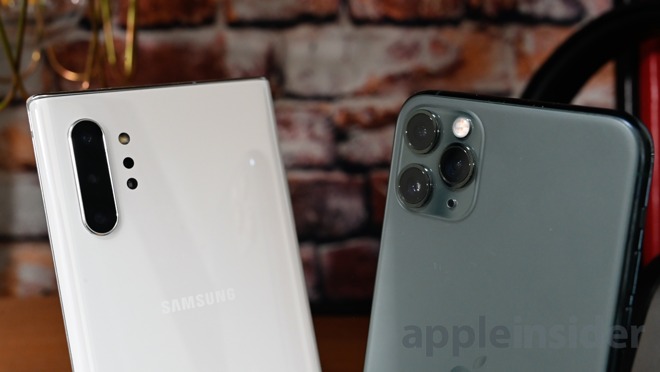
Cameras on the Note 10+ and iPhone 11 Pro Max
For photographers, this will mean a higher resolution image could be produced for Ultra-Wide shots, but only for those. There are also the assorted imaging features and processing that each smartphone offers which can influence the final shot, which may sway some users based on their personal preferred shooting style.
The Note 10+ does offer an extra party trick, in the form of the DepthVision camera, a VGA-resolution sensor which is able to acquire depth data, allowing for augmented reality experiences using the rear camera. Apple's ARKit does allow for its rear cameras to be used for similar purposes but Samsung's version may be more accurate overall due to capturing actual depth data rather than computing it from a live video feed.
Turning to the front, the aforementioned hole-punch camera in the Note 10 models offers 10-megapixel images, but the iPhone's TrueDepth camera offers 12-megapixel images, along with Portrait Mode effects that depth data can provide. Face ID, powered by the TrueDepth camera, is also a far more secure biometric system than both the single camera-based facial recognition system and the fingerprint reader offered on the Note models.
As for video, both are capable of 4K recordings at 60fps as well as the usual slow motion 1080p at 240fps, but Samsung adds in Super Slow-mo, capturing 720p video at 960fps. HDR, audio zoom, and the ability to capture still images while recording a video are also present in both ranges.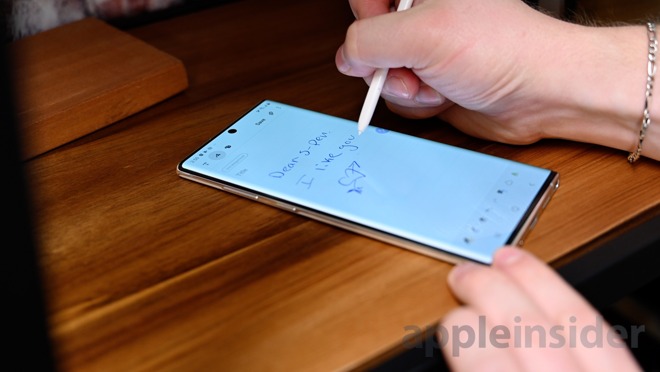
S Pen on the Samsung Galaxy Note 10+
Putting aside debatable elements like the merits of iOS over Android or the long-time rivalry between the two companies, it's actually quite hard to determine just from specifications alone which device is the best.
If we're talking displays, the Note 10+ is better than the iPhone, which is better than the Note 10. If it's photography, Samsung may have a higher-resolution Wide-Angle camera sensor, but there's only an arguable amount of benefit to that difference, before anyone takes into account image processing systems employed by each device.
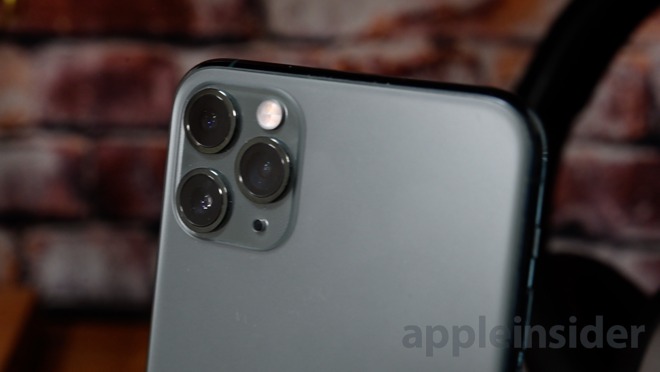
The iPhone 11 Pro Max in Midnight Green
The iPhone 11 Pro Max does come out on top in some areas, like Face ID security and the TrueDepth camera, as well as performance, but it also falls behind in aspects like the pixel density against the Note 10+ and rear camera depth sensing.
The main takeaway is that Apple is still maintaining its position at the front of the field alongside Samsung, with it producing iPhones that are at a par with the best its main rival can offer. Those who are platform agnostic would probably be quite happy using any of the devices, as they are the best of what are currently available on the market at this time.
Meanwhile, wireless carriers are offering a variety of incentives on the new iPhone 11 Pro Max, from BOGO offers to trade-in deals on devices in any condition. Highlights are below.
iPhone 11 Pro Max deals

Samsung Galaxy Note 10+ against the iPhone 11 Pro Max
Revealed just a month ahead of Apple's annual iPhone event, Samsung's Galaxy Note 10 and Note 10+ were revealed as potential smartphone powerhouses, with a large display and a rear triple-camera setup that is relatively similar to what was presented by Apple in the iPhone 11 Pro and Pro Max a few weeks later.
With the launches so close together and being the flagship models of their respective manufacturers, it is worth taking some time to compare the offerings against each other, to see who has the upper hand for the next year or so.
The Specifications List
On paper, the three are roughly similar in terms of size and what they offer. There are obvious differences, such as the Note pair having support for the S Pen while the iPhone doesn't use an Apple Pencil or any stylus at all, but ultimately the differences in the key areas people look at are quite small.| Apple iPhone 11 Pro Max | Samsung Galaxy Note 10 | Samsung Galaxy Note 10+ | |
|---|---|---|---|
| Price | $1,099 | $949 | $1,099 |
| Screen size (ins) | 6.5 | 6.3 | 6.8 |
| Resolution | 2688 x 1242 at 458ppi | 2280 x 1080 at 401ppi | 3040 x 1440 at 498ppi |
| Contrast | 2,000,000:1 | 2,000,000:1 | 2,000,000:1 |
| Brightness (nits) | 800 | 1200 | 1200 |
| Display type: | Super Retina XDR OLED, HDR, True Tone, Wide Color (P3) | Infinity-O Dynamic AMOLED, HDR10+ | Infinity-O Dynamic AMOLED, HDR10+ |
| Processor | A13 Bionic with Neural Engine | Octa Core processor, 2.7GHz + 2.4GHz + 1.9Ghz | Octa Core processor, 2.7GHz + 2.4GHz + 1.9Ghz |
| Memory | 4GB* | 8GB or 12GB | 12GB |
| Stylus Support | No | S Pen | S Pen |
| Dimensions (ins) | 5.7 x 2.8 x 0.32 | 5.9 x 2.8 x 0.31 | 6.4 x 3.0 x 0.31 |
| Weight (ounces) | 6.63 | 5.92 | 6.91 |
| Rear Cameras (megapixels) | 12MP Ultra Wide, 12MP Wide, 12MP Telephoto | 16MP Ultra Wide, 12MP Wide, 12MP Telephoto | 16MP Ultra Wide, 12MP Wide, 12MP Telephoto, VGA DepthVision |
| Video recording | 4K60 | 4K60 | 4K60 |
| Slow Mo | 1080p at 240fps | 720p at 960fps, 1080p at 240fps | 720p at 960fps, 1080p at 240fps |
| Front Camera | 12MP TrueDepth | 10MP Selfie | 10Mp Selfie |
| Biometric | Face ID | Fingerprint, Face Recognition | Fingerprint, Face Recognition |
While the basic list of specifications can certainly give the appearance of similarities in some areas and larger differences in others, like with the Note's rear cameras against Apple's being fairly close in many respects, there's more variation in the two different families of devices than numbers alone can advise about.
Display

Samsung Galaxy Note 10+ display
All models employ an OLED panel for their screens, which means both offer high levels of contrast and brightness. Indeed, since Samsung supplies Apple with OLED panels for its iPhones, the technology and quality should be quite comparable from a manufacturing standpoint.
The iPhone 11 Pro Max slots in the space between the Note 10 and Note 10+, at 6.5 inches to the Samsung 6.3 inches and 6.8 inches. The resolution is also roughly in the middle of the two Samsung models as well, with its pixel density of 458 pixels per inch sandwiched between the 401ppi for the Note 10 and the 498ppi of the Note 10+.
While you are likely to find the quality of the display on all three models to be quite agreeable, one big difference is how the two companies handled the extra components on the front of the device. Apple continues to endure with the infamous notch holding the TrueDepth camera array, while Samsung elects for a hole-punch camera design that minimizes wasted space.
It is hard to judge one over the other, as while you have more screen with the Samsung models, both do ultimately interrupt a full-screen appearance with an aberration, one that cannot easily be dismissed from view. Samsung's may be smaller, but it's still a distraction.
Performance
In theory, Samsung should be able to blow Apple out of the water with the performance of the Note 10 and Note 10+, with each Note using an 8-core Qualcomm Snapdragon 855 processor equipped with either 8GB or 12GB of memory, depending on the model. While the iPhone 11 Pro Max has just 4 gigabytes of memory to work with, its six-core A13 Bionic therefore needs all the help it can get from the Neural Engine to properly compete.
Geekbench 5 results for the iPhone 11 Pro Max (right) and the Galaxy Note 10+ (left)
In benchmark results at least, the A13 seems to have done the job. According to GeekBench, the A13 Bionic in the iPhone 11 Pro Max scores 1,329 points on single-core processing to the Note 10's 697 points, while for multi-core, Apple wins again with 3,405 to Samsung's 2,523.
The story doesn't get any better for Samsung in GeekBench's Compute benchmark, with Apple achieving 6,288 points for Metal over 2,307 for the Note 10's OpenCL score. While this isn't a direct comparison due to differing technologies, it does indicate the iPhone continues to be far in the lead in this respect.
Why is the A13 doing so well, despite having half the RAM? It is likely due to Apple's chip design choices, the fact that it has almost complete control over the entire process, and that it can make chips that work for its own needs, rather than relying on a third-party design like one from Qualcomm.
Photos and Video
Around the back, there is both a similar story between the companies, as well as considerable differences. Both Apple and Samsung went down the same route of offering three cameras, with Ultra-Wide, Wide, and Telephoto lenses.Both sides also have Optical Image Stabilization on the Wide and Telephoto cameras, as well as typical camera-shooting modes, HDR, and a 10x digital zoom, but while Apple does opt for 12-megapixel sensors across the board, Samsung uses 12-megapixel for the Wide and Telephoto but switches it out for a 16-megapixel sensor in the Ultra-Wide.

Cameras on the Note 10+ and iPhone 11 Pro Max
For photographers, this will mean a higher resolution image could be produced for Ultra-Wide shots, but only for those. There are also the assorted imaging features and processing that each smartphone offers which can influence the final shot, which may sway some users based on their personal preferred shooting style.
The Note 10+ does offer an extra party trick, in the form of the DepthVision camera, a VGA-resolution sensor which is able to acquire depth data, allowing for augmented reality experiences using the rear camera. Apple's ARKit does allow for its rear cameras to be used for similar purposes but Samsung's version may be more accurate overall due to capturing actual depth data rather than computing it from a live video feed.
Turning to the front, the aforementioned hole-punch camera in the Note 10 models offers 10-megapixel images, but the iPhone's TrueDepth camera offers 12-megapixel images, along with Portrait Mode effects that depth data can provide. Face ID, powered by the TrueDepth camera, is also a far more secure biometric system than both the single camera-based facial recognition system and the fingerprint reader offered on the Note models.
As for video, both are capable of 4K recordings at 60fps as well as the usual slow motion 1080p at 240fps, but Samsung adds in Super Slow-mo, capturing 720p video at 960fps. HDR, audio zoom, and the ability to capture still images while recording a video are also present in both ranges.
And The Winner Is...?

S Pen on the Samsung Galaxy Note 10+
Putting aside debatable elements like the merits of iOS over Android or the long-time rivalry between the two companies, it's actually quite hard to determine just from specifications alone which device is the best.
If we're talking displays, the Note 10+ is better than the iPhone, which is better than the Note 10. If it's photography, Samsung may have a higher-resolution Wide-Angle camera sensor, but there's only an arguable amount of benefit to that difference, before anyone takes into account image processing systems employed by each device.

The iPhone 11 Pro Max in Midnight Green
The iPhone 11 Pro Max does come out on top in some areas, like Face ID security and the TrueDepth camera, as well as performance, but it also falls behind in aspects like the pixel density against the Note 10+ and rear camera depth sensing.
The main takeaway is that Apple is still maintaining its position at the front of the field alongside Samsung, with it producing iPhones that are at a par with the best its main rival can offer. Those who are platform agnostic would probably be quite happy using any of the devices, as they are the best of what are currently available on the market at this time.
Where to buy
The Samsung Galaxy Note 10+ is available at B&H Photo and from Samsung directly. Each retailer is offering free Galaxy Buds with the Note+, as well as free service options (free Mint Mobile service for three months at B&H or four months of ad-free YouTube service at Samsung). Details of each promotion, including terms and conditions, can be found on the respective retailer's site.Meanwhile, wireless carriers are offering a variety of incentives on the new iPhone 11 Pro Max, from BOGO offers to trade-in deals on devices in any condition. Highlights are below.
iPhone 11 Pro Max deals
- Verizon Wireless: Get up to $450 off the iPhone 11 Pro Max via bill credits with select trade-in and Unlimited plan.
- AT&T Wireless: Buy an eligible iPhone and get the iPhone 11 for free when you buy both on a qualifying installment plan with an eligible AT&T unlimited plan.
- Sprint: Starting at $12.50 per month with Sprint Flex lease and select trade-ins in any condition
- Walmart: Save up to $100 on the iPhone 11 Pro. Offer valid only on purchase with installment plan through AT&T or Verizon.
- Sam's Club: Get a $150 Sam's Club gift card when you buy and activate an iPhone 11 Pro or iPhone 11 Pro Max by Nov. 8.


Comments
Apple's processors win because Apple jumped to 64-bit ARM design and SoC implementation with the iPhone 5S, at least 2 years ahead of when everyone else was planning to do so. The competition called 64-bits a gimmick, because they were caught flat-footed. And they're still working to catch up. The A13 wins on its merit, not because of some odd behavior required to "properly compete."
iPhones receive first-class support for iOS for at least 5 years. How does Samsung compare in this regard with Android?
A few years ago I was shopping for a TV and went to Best Buy to compare the pictures. While I could see a difference in the store, the differences were subtle and I realized that once I got the TV home in my living room I would never notice or care. Phones these days are the same - When the Xr came out, people made a big deal about the fact that it lacked an OLED screen, but as a practical matter, no one I asked could tell the screens apart. Bottom line, you won't be disappointed with the screen on either the Samsung or the iPhone.
For starters, no Android device display can touch the iPhone because Android has a horrible version of color management. Nobody can render content anywhere nearly as accurate as the iPhone. As to pixel count, both are so high nobody could ever tell the difference.
The brightness spec is wrong. You can measure peak brightness in a small area of the screen or over the entire screen. Bottom line is the iPhone has the brighter screen and Samsung is playing with numbers when they quote 1,200 nits.
Cameras? Try to record a video and switch between cameras during the video. The Note 10 often stutters and has to refocus when changing. The iPhone does this seamlessly.
Just a couple obvious examples.
I’ll add my preferences;
1. Android apps from Google are all designed to mine user data for targeted ads. That’s how Google makes most of its $ & it’s why its apps are free.
- By contrast, Apple does a better job protecting my privacy.
Apple does this by putting much of the cost of apps as part of the price of the phone. I’m willing to pay that price.
2. Samsung phones have bloatware. There are Google apps & as many Samsung apps which have the same features. The phone carrier may add more apps.
- iPhones begin with a much “cleaner”/slimed down app experience. No bloat.
3. Quality of login (mostly a repeat from the video);
- It has been reported that the S10 fingerprint reader has accuracy problems. The Samsung facial recognition is not 3D & can be fooled.
- Apple is much more careful w/ its Face ID which uses 3D tech & is very hard to fool.
I do want an under screen fingerprint sensor but only when it can be done right.
4. In terms of camera color accuracy Apple has done a better job than Samsung.
5. Android phones are lucky to have 2 years of OS updates.
iPhones (with iOS updates) are designed to last ~5 years. The iPhones are very powerful & so can handle several years of new OS features.
Remember when all of the "iPad Killers" were being released every week some years back?
And then when multicore Android phones began coming out many years ago?
Some of those devices had better "paper specs", but they all failed.
Apple has always been kicking their butts. Who cares if a Fandroid lunatic claims that their 8 core whatever device is more powerful when Apple devices with much less cores have always left them in the dust.
Android has always been an inefficient and crap OS, which is probably why it needs so much RAM etc.
Android has often had higher Paper Specs than comparable Apple devices going back to the very beginning, but what matters is how the device itself functions, not how something looks on a piece of paper. A person doesn't carry a piece of paper with specs in their pocket, they carry a device that they intend to use and do things on. You can't make a phone call with a piece of paper and you can't surf the internet or open an app on a piece of paper.
I don't care if somebody comes out with an Android device featuring a 64 core CPU and with 64 GB RAM, it will still be garbage in my humble opinion, as it still relies on Android. The brain is the most important part of the human body, and a dumb brain makes a dumb person, and an inferior CPU combined with a low IQ OS like Android, makes for a pretty dumb device.
One example - " Putting aside debatable elements like the merits of iOS over Android or the long-time rivalry between the two companies " so you are comparing ONLY on hardware specs?
What about the speed of the os on its given hardware?
And what two companies? 'Android' isn't a company. I'd guess you meant to imply Samsung, but I'm not sure there is a rivalry with Apple. Does Samsung make an OS? A computer? Does Apple make washers and dryers? I just think all kinds of things are being confused and tossed in this piece in order not to hurt feelings. And if you are actually doing a review and than saying 'but we won't look at the os' what is the point? Just run tech specs, take your free Samsung phones and move on. Honestly, this is a badly written and rather silly piece. I'm not attacking the writer. I'm criticizing the entire editorial system that puts this out. By the end I don't know what I've read, if the reviewer has an opinion (most reviewers have opinions...that's OK. Explain your opinion and let others decide) but don't pretend all is equal, i love everything, boy these are both so good...why bother writing it then?
the automatic Night Mode is amazing. For my uses it’s been a 1-2 exposure and it just comes out really nice, it’s like magic. This is how it’s supposed to be done.
Man I wish you were in the thread where someone was arguing with me about Sammy having a better screen. Not even close.
For $1099 the iPhone gives you 64GB while the Note gives you 256GB, big difference when you can simultaneously shoot with 4K on multiple cameras.
As for the screen, until the iPhone 11 came about, the Note was recognized as having the A+ screen.
Then the Galaxy S11 will come out, and it will considered the best.
Then the Note 11 and then the iPhone 12 will be top until the next Galaxy flagship or until the iPhone comes along with its new micro led screen perhaps, who knows? It's swings and roundabouts.
To say any of the screens or cameras on any of these phones is significantly better than the other is rubbish really, they both have strengths and weaknesses.
Personally, I'd want more memory on an iPhone, 4GB in 2019 flagship costing up to $1499 is just being cheap. Sure, iOS does better with less ram but it also seems to struggle keeping certain apps open in the background.
Look what happened when apple threw a big battery in their new phones, instant battery god phone, why not double the memory, it wouldn't cost much and you'd make a lot of people happier, even 6GB would have made a difference.
https://www.youtube.com/watch?v=CusxWlCsTfQ
Anyway, both phones are great, choose the one you want.